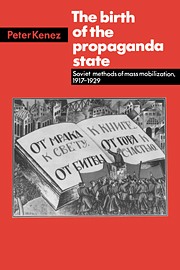Book contents
- Frontmatter
- Contents
- List of illustrations
- Preface
- Introduction: The Soviet concept of propaganda
- Part I The Civil War
- Part II The new economic policies
- 6 Political education
- 7 The literacy campaign
- 8 The Komsomol in the 1920s
- 9 The golden age of the Soviet cinema
- 10 The press and book publishing in the 1920s
- Conclusion and epilogue
- Notes
- Glossary
- Bibliography
- Index
10 - The press and book publishing in the 1920s
Published online by Cambridge University Press: 02 December 2009
- Frontmatter
- Contents
- List of illustrations
- Preface
- Introduction: The Soviet concept of propaganda
- Part I The Civil War
- Part II The new economic policies
- 6 Political education
- 7 The literacy campaign
- 8 The Komsomol in the 1920s
- 9 The golden age of the Soviet cinema
- 10 The press and book publishing in the 1920s
- Conclusion and epilogue
- Notes
- Glossary
- Bibliography
- Index
Summary
Newspapers
A casual observer looking at a Soviet newspaper from the 1920s is likely to be struck by the dull format and style and by the thin and repetitious content. It is hard to reconcile these papers with our image of the Bolsheviks as master propagandists. Could such predictable and boring articles ever win over a reader? It is, of course, impossible to know whether a single article or a series of articles ever convinced many people. But notwithstanding the dullness of the press, it is evident that the network of newspapers played a decisively important role in the establishment and functioning of the Soviet regime. The newspaper network was the blood-circulation system of the body politic: It carried esential information everywhere rapidly – at least after the difficult years of crisis. The average citizen learned what were the legitimate public issues as defined by the leaders and learned the verbiage of political discourse. For the activist and for the Party functionary, reading the newspaper diligently was even more important. They found out how they had to act in small and large matters and learned how to discuss political and even nonpolitical issues with their fellow citizens.
The problems of increasing circulation. In the short run the introduction of the NEP was a disaster for the Soviet press. Under war communism a most peculiar system existed: Newspapers received what they needed free and in turn, they distributed their product also without payment. How many copies and which newspapers appeared depended on the availability of paper. How the extremely scarce paper supply was distributed depended above all on the strength of the sponsoring agency.
- Type
- Chapter
- Information
- The Birth of the Propaganda StateSoviet Methods of Mass Mobilization, 1917-1929, pp. 224 - 250Publisher: Cambridge University PressPrint publication year: 1985



